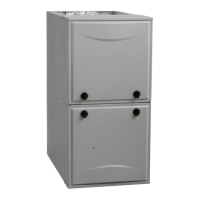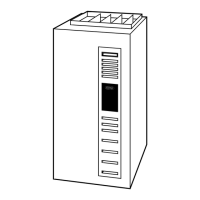F80CTL and G80CTL: Installation, Start–Up, Operating and Service and Maintenance Instructions
Manufacturer reserves the right to change, at any time, specifications and designs without notice and without obligations.
44
furnace blower motor BLWM at low-cooling airflow which is the
true on-board CF (continuous fan) selection, see Fig. 14. The
R-to-Y1-and-Y2 circuits start the outdoor unit on high-cooling
speed, and the R-to-G-and-Y/Y2 circuits start the furnace blower
motor BLWM at high-cooling airflow. High-cooling airflow is
based on the A/C (air conditioning) selection, see Fig. 14.
The electronic air cleaner terminal EAC-1 is energized with 115
vac whenever the blower motor BLWM is operating.
When the thermostat is satisfied, the R-to-G-and-Y1 or R-to-
G-and-Y1-and-Y2 circuits are opened. The outdoor unit stops,
and the furnace blower BLWM and electronic air cleaner
terminal EAC-1 will remain energized for an additional 90
seconds. Jumper Y1 to DHUM to reduce the cooling off-delay to
5 seconds, see Fig. 32.
4. Dehumidify Mode
See Fig. 28 - Fig. 31 for thermostat connections.
The dehumidification output, DHUM on the Thermostat should be
connected to the furnace control thermostat terminal DHUM. When
there is a dehumidify demand, the DHUM input is activated, which
means 24 vac signal is removed from the DHUM input terminal. In
other words, the DHUM input logic is reversed. The DHUM input
is turned ON when no dehumidify demand exists. Once 24 vac is
detected by the furnace control on the DHUM input, the furnace
control operates in dehumidify mode. If the DHUM input is low for
more than 48 hours, the furnace control reverts back to
non-dehumidify mode.
The cooling operation described in item 3. above also applies to
operation with a thermostat. The exceptions are listed below:
a. Low cooling-When the R-to-G-and-Y1 circuit is closed and
there is a demand for dehumidification, the furnace blower motor
BLWM will drop the blower airflow to 86 percent of low-cooling
airflow which is the true on-board CF (continuous fan) selection,
see Fig. 14.
b. High cooling-When the R-to-G-and Y/Y2 circuit is closed and
there is a demand for dehumidification, the furnace blower motor
BLWM will drop the blower airflow to 86 percent of
high-cooling airflow. High-cooling airflow is based on the A/C
(air conditioning) selection, see Fig. 14.
c. Cooling off-delay-When the “call for cooling” is satisfied and
there is a demand for dehumidification, the cooling blower-off
delay is decreased from 90 seconds to 5 seconds.
5. Super-Dehumidify Mode
Super-Dehumidify mode can only be entered if the furnace control
is in the Dehumidify mode and there is a demand for
dehumidification. The cooling operation described in item 3. above
also applies to operation with a thermostat. The exceptions are
listed below:
a. When the R-to-Y1 circuit is closed, R-to-G circuit is open, and
there is a demand for dehumidification, the furnace blower motor
BLWM will drop the blower airflow to 65 percent of low-cooling
airflow for a maximum of 10 minutes each cooling cycle or until
the R-to-G circuit closes or the demand for dehumidification is
satisfied. Low-cooling airflow is the true on-board CF
(continuous fan) selection, see Fig. 14.
b. When the R-to-Y/Y2 circuit is closed, R-to-G circuit is open, and
there is a demand for dehumidification, the furnace blower motor
BLWM will drop the blower airflow to 65 percent of
high-cooling airflow for a maximum of 10 minutes each cooling
cycle or until the R-to-G circuit closes or the demand for
dehumidification is satisfied. High-cooling airflow is based on
the A/C (air conditioning) selection, see Fig. 14.
c. When the “call for cooling” is satisfied and there is a demand for
dehumidification, the cooling blower-off delay is decreased from
90 seconds to 5 seconds.
6. Continuous Blower Mode
When the R-to-G circuit is closed by the thermostat, the blower
motor BLWM will operate at continuous blower airflow.
Continuous blower airflow selection is initially based on the CF
(continuous fan) selection, see Fig. 14. (The factory default is
shown in Fig. 14. Terminal EAC-1 is energized as long as the
blower motor BLWM is energized.
During a call for heat, the furnace control CPU will transition the
blower motor BLWM to continuous blower airflow, low-heat
airflow, or the mid-range airflow, whichever is lowest. The blower
motor BLWM will remain ON until the main burners ignite then
shut OFF and remain OFF for the blower-ON delay (45 seconds in
low-heat, and 25 seconds in high-heat), allowing the furnace heat
exchangers to heat up more quickly, then restarts at the end of the
blower-ON delay period at low-heat or high-heat airflow,
respectively.
The blower motor BLWM will revert to continuous-blower airflow
after the heating cycle is completed. In high-heat, the furnace
control CPU will drop the blower motor BLWM to low-heat airflow
during the selected blower-OFF delay period before transitioning to
continuous-blower airflow.
When the thermostat “calls for low-cooling”, the blower motor
BLWM will switch to operate at low-cooling airflow. When the
thermostat is satisfied, the blower motor BLWM will operate an
additional 90 seconds at low-cooling airflow before transitioning
back to continuous-blower airflow.
When the thermostat “calls for high-cooling”, the blower motor
BLWM will operate at high cooling airflow. When the thermostat is
satisfied, the blower motor BLWM will operate an additional 90
seconds at high-cooling airflow before transitioning back to
continuous-blower airflow. When the R-to-G circuit is opened, the
blower motor BLWM will continue operating for an additional 5
seconds, if no other function requires blower motor BLWM
operation.
NOTE: If the blower-off delay is set to the maximum, the adjustable
continuous-fan feature is locked (i.e., fan speed cannot be changed from
its current setting).
7. Heat pump
See Fig. 30 - Fig. 31 for thermostat connections.
When installed with a heat pump, the furnace control automatically
changes the timing sequence to avoid long blower off times during
demand defrost cycles. Whenever W/W1 is energized along with
Y1 or Y/Y2, the furnace control CPU will transition to or bring on
the blower motor BLWM at cooling airflow, low-heat airflow, or
the mid-range airflow, whichever is lowest. The blower motor
BLWM will remain on until the main burners ignite then shut OFF
and remain OFF for 25 seconds before coming back on at heating
airflow. When the W/W1 input signal disappears, the furnace
control begins a normal inducer post-purge period while changing
the blower airflow. If Y/Y2 input is still energized the furnace
control CPU will transition the blower motor BLWM airflow to
cooling airflow. If Y/Y2 input signal disappears and the Y1 input is
still energized the furnace control CPU will transition the blower
motor BLWM to low-cooling airflow. If both the Y1 and Y/Y2
signals disappear at the same time, the blower motor BLWM will
remain on at low-heat airflow for the selected blower-OFF delay
period. At the end of the blower- OFF delay, the blower motor
BLWM will shut OFF unless G is still energized, in which case the
blower motor BLWM will operate at continuous blower airflow.
8. Component test
The furnace features a component test system to help diagnose a
system problem in the case of a component failure. To initiate the
component test procedure, ensure that there are no thermostat

